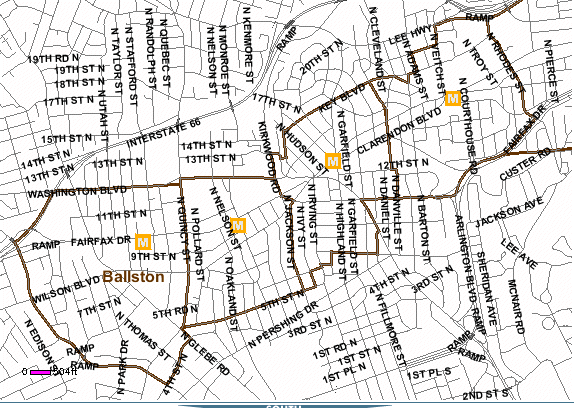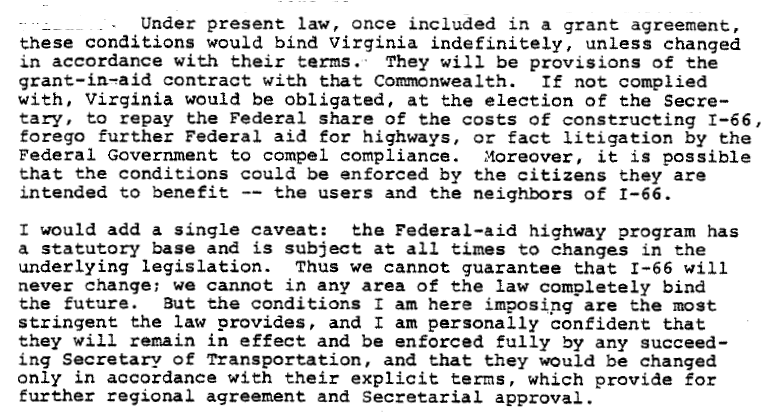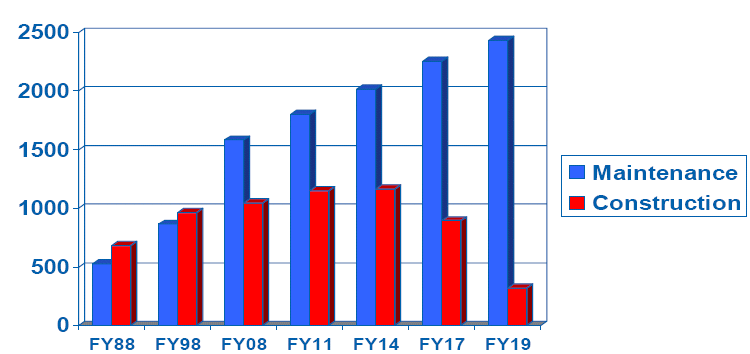
Arlington County planning districts around Metro stations
Source: Arlington County - GIS Interactive Maps (2008)
Metrorail through Arlington County created the model "smart growth" development in Northern Virginia, the Rosslyn-Ballston corridor. The low-rise, low-density, low-value commercial strip along Wilson and Fairfax boulevards 40 years ago has been replaced by high-rise, high-density, high-value downtown that stretches for 5 Metro stations.
People live, work, shop, and entertain themselves in an urban setting with more office space than downtown Dallas, Pittsburgh, or Denver. Metro stations on the Blue Line also became nodes for new development. Land around the 7 stations includes one-tenth or less of the county’s land area, but produces more than half of Arlington County's tax revenues.
The key decision in 1968 was to route the Orange Line through the existing developed area and zone for redevelopment, rather than to accept the original plan to route Metrorail in the planned median of I-66. Instead of isolating the transit so far from development that everyone would choose to drive to a parking lot, Arlington placed transit within 1/4 mile of its planned redevelopment area. Most people can walk 1/4 mile in about 5-10 minutes, so people living/working that close to the Metro station do not feel they need to use a car.
As a result, today almost 25% of Arlington residents use transit to get to work, while the national average is less than 5%. In Arlington, over 10% of the residents don't even own a car - what a contrast to the lifestyle of suburban Stafford or Loudoun. 1

Fairfax County chose a different strategy when designing the route of Metro. It placed the Orange Line at a distance from any existing development, in the middle of I-66 (which was "free" and involved no acquisition or tunneling costs). Then, instead of zoning the land around Metro stations for dense development, Fairfax allowed Metro to build parking lots that isolated the stations even more from surrounding development. It required a 1/4 mile walk just to cross the pavement to reach the trains.
The final failure was the county's unwillingness to zone for tall tower development next to the Vienna station, at the end of the Orange Line. After local opposition to increased traffic from proposed new development, Fairfax authorized only low-rise townhome developments to the north and west of the station. Both were completed within the last 10 years, so that residential land is not ready for redevelopment into a mixed use town center.
However, south of the Vienna Metro station, an existing neighborhood could be replaced by new, high-rise development. Fairfax may finally develop one Metro station along the lines of the Arlington model.
Read:
Despite the failure of Fairfax County to emulate its neighbor until recently, the success of the Arlington experience is well understood across the country. Read:
Now Arlington wants to extend revitalization away from the Metro corridor. Backers of the $100+ million plan to build a trolley along Columbia Pike justify that public investment in part on the expectation that transit services will revitalize or facilitate economic growth. Unlike expansion of I-66 and I-95, the Columbia Pike trolley is not designed primarily to help commuters get to work. Instead, the trolley is intended to facilitate circulation of residents, workers, and shoppers along the whole corridor, which should increase the value of parcels within walking distance (about three blocks) of the trolley route.
Read:
Current traffic congestion on I-66 in Arlington is due to regional commuters clogging the highway, not local Arlington residents. The county has pushed for mass transit over highway construction for the last 40 years. As part of the decision to shift funding from planned freeways to build the Metrorail system, transportation agencies in the Washington area dropped plans for extending I-66 across the Potomac, through Georgetown and the rest of the District of Columbia. Instead of constructing a new bridge where the "Three Sisters" islands are located near Spout Run, the eastern end of I-66 was connected to the Teddy Roosevelt Bridge.
Because I-66 was proposed to cut through existing neighborhoods, Arlington residents insisted that the highway be restricted in width to minimize the impact. In 1977, Secretary of Transportation William Coleman decided that the 10 miles of I-66 between the Beltway and the Potomac River would be downsized from 8 to 4 lanes, trucks were banned, and only vehicles with four or more passengers (now reduced to HOV-3) would allowed during rush hours.


Key points in Coleman decision, limiting width of I-66 inside Beltway (1977)
Source: VDOT
Secretary Coleman made his decision before the final decision was made to build Metro past Ballston to a station in Vienna. He gambled that transit services would reduce demand for auto traffic, allowing the interstate width to be limited. He also understood that his decision could be changed, unlike an easement on property that would be perpetual.
In 1999, Congress released Virginia from its commitments in the Coleman decision, including the limitation on the number of lanes, except for the requirement to allow Dulles airport traffic during HOV periods and to ban heavy trucks. While smart growth advocates continue to prefer investment in mass transit over highway improvements in dense Arlington County, the last three Virginia governors have supported modifying the Coleman decision in order to respond to revised traffic patterns. VDOT is now planning to widen I-66 westbound, using the existing right-of-way, and make other "spot improvements" to reduce congestion in the afternoons.
The general public has endorsed the concept that transit-oriented development is "smart," as recognized by the Realtors. Linking transportation improvements to land use decisions is now "duh, of course" conventional thinking. Read:
However, we still do not make those links in Northern Virginia. Counties can approve as many subdivisions as they desire, wherever local officials think new housing is appropriate. Developers then build roads in those subdivisions to state standards, and VDOT is obliged to accept the roads into the state system. That adds to the maintenance burden on VDOT, which is diverting funds away from new construction in order to meet maintenance obligations. There is no incentive for counties to require developers to reduce the number of lanemiles being added into the state-mnaintained road system.
Within 10 or so years (various alarmist reports from VDOT suggest different dates), VDOT will have to dedicate 100% of its resources to maintenance of existing infrastructure. Unless new funds are provided, VDOT will no longer be able to build new roads or widen existing roads to increase capacity. Congestion may grow, but VDOT has limited funds... at least until the General Assembly or the voters approve new taxes/fees.

Governor Kaine modified the transportation legislation in 2006, and the General Assembly accepted his changes to the currently-disconnected processes for land use and transportation planning. He required that counties get their Comprehensive Plans reviewed by VDOT, and that new developments beyond a certain size must also get reviewed - starting first in Northern Virginia.
Though the state does not have the authority to block a local land use decision, the reviews have already been effective at shaping the rezonings for proposed Dulles South projects (which the Loudoun Board of County Supervisors ultimately rejected).
Read:
A close examination of the linkage between land use and transportation may create tensions within Northern Virginia. Some inner- vs. outer-region conflicts were already exposed when the Virginia Department of Rail and Public Transportation modified plans in 2008 to provide transit services on the I-95/I-395 corridor as High Occupance Toll lanes are built. The original plans provided a major expansion of bus services inside the Beltway. However, the Department of Rail and Public Transportation's final plans reduced those bus services in exchange for improving VRE and bus transit from outside the Beltway - facilitating the commute into DC from south of Fredericksburg.
Competition between inner suburbs with jobs vs. outer suburbs with housing should heat up soon, as the General Assembly debates how to raise taxes to fund new roads/transit. At some point, the outer suburbs will finally realize that "more of the same" will not solve their transportation problems.
If outer suburb counties continue to advocate for building more transit/highway transportation links to existing job centers (Tysons Corner/Arlington/DC), then current housing and commuting patterns will continue. People will buy low-cost housing far from high-wage jobs, then demand government agencies raise taxes somehow to solve the congestion problem for commuters - and provide high-quality services in areas of low-density population, while keeping taxes low.
If bedroom counties want to make life easier for more commuters, then they guarantee more school construction costs. Stafford/Prince William/Loudoun will build the schools, while Arlington/Alexandria/Fairfax get more commercial property tax revenues from expanded office buildings. Hmmm... think it might be economic suicide for the bedroom counties to seek subsidies for commuters to work in the inner suburbs? Think 'more of the same ol, same ol'" is not the right answer for the counties on the periphery of growth?
What is "smart" for one part of Northern Virginia is "dumb" for the bedroom communities. Residents of the inner suburbs might love to perpetuate the pattern, so their property taxes will drop while property taxes in outer suburbs will climb. Then Fairfax County could afford to subsidize efforts to convert Lorton prison into an arts center, while Loudoun and Fauquier may find themselves unable to subsidize horse farms and other agricultural land uses.
